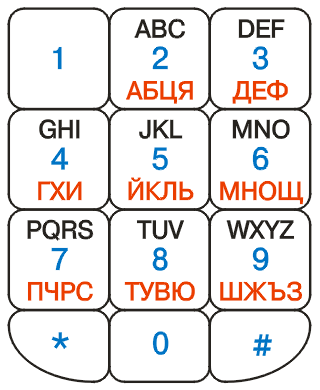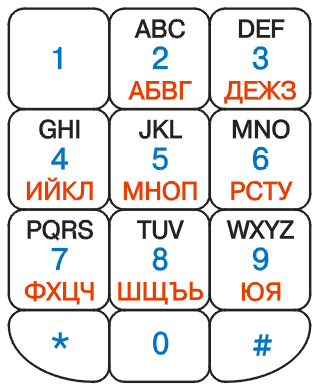 |
(for Bulgarian language) |
We suggest the solution for the phonetic keyboard problem to be excepting it as a national standard with the BDS. Except for the computers we suggest to be approved a phonetic keyboard for the cell phones too.
![]() For the phonetic keyboard on the cell phones we suggest it to be accepted as a second option and to be kept the present alphabet sequence for the people that are used to it and have the Cyrillic letters on their phones.
For the phonetic keyboard on the cell phones we suggest it to be accepted as a second option and to be kept the present alphabet sequence for the people that are used to it and have the Cyrillic letters on their phones.
The phonetic keyboard offers the use of 26 letters from the Cyrillic alphabet to be the same as the use of the Latin letters, except Þ, ß, Ù and Ü. The 26 letters will be positioned on the Latin keyboard the way it was suggested about the transliteration. We are paying attention to the fact that 22 of these letters are positioned the same way in the present phonetic keyboard standard for computers. The differences are only with the letters Â, Æ, Ø, ×. The letters Ø and × don't correspond with a Latin letter in the phonetic keyboard for computers and there is no way for them to remain on the same key. The changes related to the letters  and Æ are because we consider that it would be better for  to correspond with V, not with W.
We only have to say where the letters
Þ, ß, Ù and Ü are going to be positioned. They are going to be a fourth letter on the following keys:
| Þ on 8 (tuv) | Ù on 6 (mno) |
| ß on 2 (abc) | Ü on 5 (jkl) |
That's how the phonetic and the alphabetic keyboards look like:
 |
 |
|
|
|
![]() For the phonetic keyboard for computers we suggest to be accepted 7 changes of the present standard. That's how we can achieve ergonomics and how this keyboard can be conformed with the phonetic one for GSM and with the suggested transliteration. The suggested changes are the following:
For the phonetic keyboard for computers we suggest to be accepted 7 changes of the present standard. That's how we can achieve ergonomics and how this keyboard can be conformed with the phonetic one for GSM and with the suggested transliteration. The suggested changes are the following:
| Â on V | Ü and È grave on | | × on Q | Ø on W |
| Æ on X | Þ on ~ | ß on [ |
So every letter is going to be on the key with the corresponding letter from the Latin alphabet (following the suggested transliteration standard).Exception will make the letters Þ, ß, Ù, Ü and È grave. It is interesting how Ü and È grave are going to be on one key. We are going to use that they are both being used mostly not as capital letters but in the middle of the word. So on this key it is going to be positioned the ü (small) and with pressing the Shift button it will appear the è grave (small) instead of Ü (capital).You still have the opportunity to use the capital letters in the Caps Lock mode, used for writing texts in capital letters. In this mode instead of ü (small) and è grave (small) will show up the same but capital. That's how we can have four symbols on one key.
When we choose È grave on the keyboard we have to enter the Unicode symbol with the code 045D or 040D respectively for the small and the capital È grave.
We suggest the symbols for Euro and number to be added respectively above the numbers 6 and 3. The necessity of adding the Euro symbol we believe that is obvious and the number symbol can be added because it exists in the BDS keyboard.
To correct the phonetic keyboard we have conformed to the following things:
First, B on V. This change we consider that is natural because that's the way it is coded in the standard accepted from the government. It is also natural the least used letter Ü to be moved on the most uncomfortable key |. Analogically the second letter that is least used Þ should be positioned on the next uncomfortable key ~. The changes with Ø, × and Æ are related to the already done changes and to our desire to conform the phonetic keyboard for GSM and computers with the transliteration standard.
The new phonetic keyboard is going to look like that. If you want to install it to your computer, click here.
![]() We also suggest to be made changes with the BDS keyboard. By now there is one keyboard both for computers and typewriters. We think for best the standards to become two - the one for typewriters to be kept without changes and the one for computers to have these little corrections: adding the È grave and the Euro and number symbols; È grave to be put on the same key, where now is
Ü by combinating them on one key the same way like in the phonetic keyboard suggestion. The Euro and the number symbols to be put on the places where now are I and V. These symbols are not really necessary in the computer keyboard because you can input them by switching the keyboard layout from Cyrillic to Latin.
We also suggest to be made changes with the BDS keyboard. By now there is one keyboard both for computers and typewriters. We think for best the standards to become two - the one for typewriters to be kept without changes and the one for computers to have these little corrections: adding the È grave and the Euro and number symbols; È grave to be put on the same key, where now is
Ü by combinating them on one key the same way like in the phonetic keyboard suggestion. The Euro and the number symbols to be put on the places where now are I and V. These symbols are not really necessary in the computer keyboard because you can input them by switching the keyboard layout from Cyrillic to Latin.
The new BDS keyboard is going to look like that. If you want to install it, click here.
| Back to the first page of the initiative | Back to: |